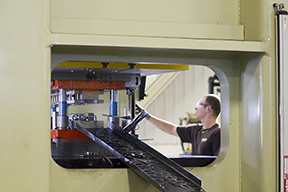 Several severe injuries recently occurred in metal fabrication operations and machine shops insured by West Bend. These accidents resulted from in-rolling nip points, inadequately guarded punch presses, and other improperly-guarded manufacturing machinery. These losses will significantly influence the manufacturers’ future Workers’ Compensation premiums and WC mods. What’s worse, these accidents caused extremely severe, potentially life-changing injuries to valuable employees.
Several severe injuries recently occurred in metal fabrication operations and machine shops insured by West Bend. These accidents resulted from in-rolling nip points, inadequately guarded punch presses, and other improperly-guarded manufacturing machinery. These losses will significantly influence the manufacturers’ future Workers’ Compensation premiums and WC mods. What’s worse, these accidents caused extremely severe, potentially life-changing injuries to valuable employees.
All these injuries could have – and should have – been prevented. When management properly guards production machinery, they’re protecting their employees. Management should protect their work force by applying a three-pronged approach for safety in their production processes: 1.) Engineering, 2.) Education, and 3.) Enforcement.
Engineering is the BEST and preferred choice for addressing safety and machine guarding. Properly engineering the manufacturing process and using machine-guarding techniques can prevent employee injuries in manufacturing operations. Education and enforcement are additional ways to help prevent losses, but are not as effective as engineering controls.
Here are ways to protect your employees:
Point-of-operation guarding - properly protecting the area where the metal production work is completed. Examples include, but are not limited to light curtains, interlocks, barrier guards, two-hand trip mechanisms, and pull-back devices to keep the operator’s hands out of the work zone. Point-of-operation guarding should always be implemented for the front, rear, and sides of the production machinery to properly safeguard the worker and other employees.
Power transmission guarding – enclosing the drive mechanisms of the machinery so there are no exposed belts, pulleys, gears, etc. that could contact the machine operator.
Personal protective equipment – Requiring employees to wear safety glasses, short-sleeved shirts, steel-toed work shoes, and hairnets or hold-back clips so loose hair doesn’t come in contact with the machine. Other considerations include no-jewelry requirements based on the particular exposure.
Using this information to improve machine guarding and protect your employees can help minimize, and even eliminate, potential injuries.
This blog was written by John Moake, a Loss Control Representative for West Bend.




